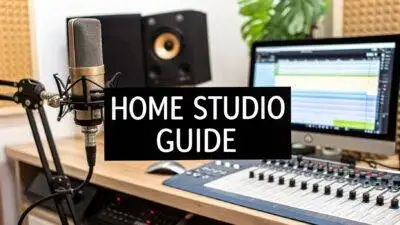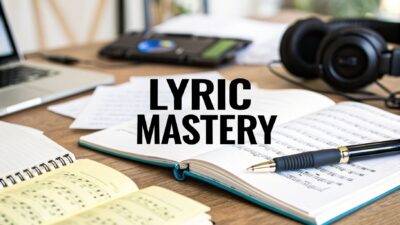Learning how to structure a song isn't about following a rigid formula. It's about creating a proven map for your listener's emotional journey. You're arranging the core building blocks—the verses, choruses, and bridges—to tell a compelling story, deliver a hook that sticks, and keep your audience captivated from the first note to the last.
The Blueprint of a Memorable Song
Before you even think about lyrics or melodies, getting a handle on song structure gives you the framework for everything that follows. Think of it less like a set of rules and more like a collection of architectural plans that have been used to build countless hit songs. These structures are popular for a reason: they tap into human psychology, creating a satisfying push and pull between what’s familiar and what’s new.
The main idea is to guide your listener. You never want them to feel lost or, even worse, bored. A solid structure is your reliable guide, making the song feel intentional and ensuring your emotional message lands just right. Understanding this blueprint is your first step toward writing music that not only expresses your vision but truly connects with people.
The Power of Familiar Patterns
Ever wonder why so many hit songs feel instantly familiar, even on the first listen? It's because they often share a similar underlying framework. This isn't a sign of creative laziness—it's a smart use of listener expectation. When you use an established pattern, you create a sense of comfort that lets the truly unique parts of your song—your specific melody, your powerful lyrics, your heartfelt performance—really stand out.
These foundational patterns are built from a few key components:
- Verse: This is your storytelling section. It’s where you set the scene, introduce characters, and build the narrative.
- Chorus: This is the musical and emotional peak. It carries your main message and, most importantly, the hook that people can't get out of their heads.
- Bridge: This section is your musical detour. It offers a fresh perspective, lyrically or musically, before skillfully guiding the listener back to the main theme.
The Hit Song Formula
The massive success of most pop hits isn't just random luck. It’s often directly tied to a structure that’s fine-tuned for maximum listener engagement. When researchers analyze top-charting tracks, a consistent format emerges that perfectly balances storytelling with repetition.
Most hits follow a classic verse-chorus-verse-chorus-bridge-chorus structure, a design built for memorability and emotional punch. In this proven model, the chorus is repeated several times and often makes up about 40% of the entire song, drilling that central hook into the listener’s memory. If you're curious, you can dive deeper into these music industry trends and findings to see just how much structure influences commercial success.
A great song structure is like telling a great story. It has a clear beginning (intro/verse), a rising action (pre-chorus), a climax (chorus), a plot twist (bridge), and a satisfying conclusion (outro).
To get started, it's crucial to understand the specific job of each part. Think of them as the tools in your songwriting toolkit. The table below gives you a quick rundown of these primary building blocks.
Core Song Sections and Their Purpose
This table summarizes the main components you'll be working with. Knowing what each section is supposed to do will help you assemble them into a cohesive and powerful song.
| Song Section | Primary Function | Typical Placement |
|---|---|---|
| Verse | Tells the story and provides context | Between the intro and first chorus |
| Chorus | Delivers the main hook and central theme | After each verse and pre-chorus |
| Bridge | Offers musical and lyrical contrast | After the second chorus, before the final chorus |
| Pre-Chorus | Builds tension leading into the chorus | Directly before the chorus |
Once you have a firm grasp on these core sections, you can start experimenting with how they fit together to serve your unique musical idea.
Anatomy of a Song: Core Sections Explained
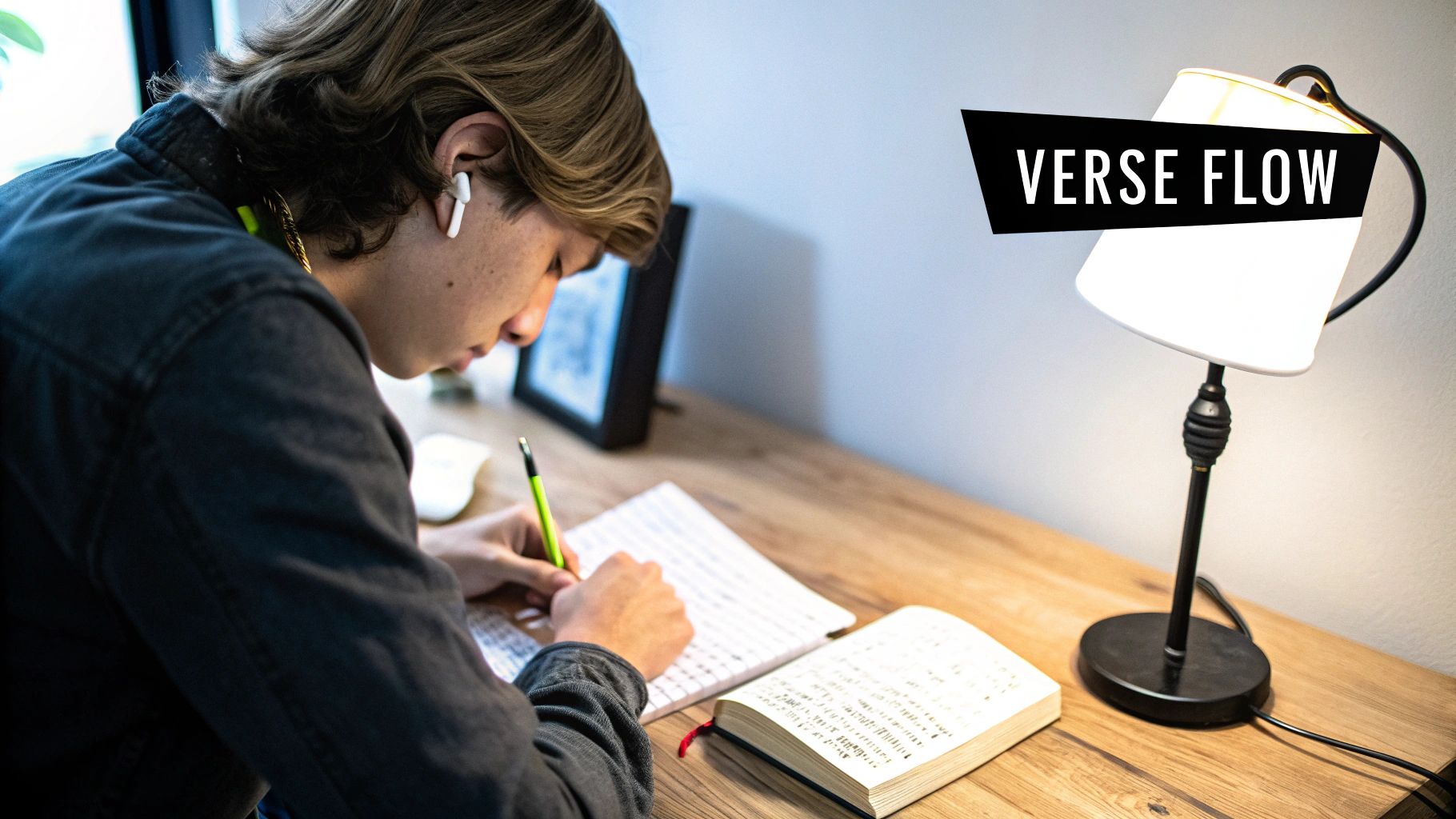
Knowing the basic building blocks of a song is one thing. But learning how to make them work together is where the real magic happens. Let’s get past the textbook definitions and dig into how each section contributes to a song's emotional and narrative journey. Once you understand the job of each part, you can start structuring your own songs with confidence.
Think of your intro and outro as the song's welcome mat and its final goodbye. A great intro grabs the listener and sets the scene, while the outro gives them a sense of closure. These aren't just afterthoughts; they are the bookends to the entire experience, making someone want to listen and, hopefully, hit replay.
The Intro: Your Hook Before the Hook
This is your first impression. It has one critical mission: to establish the song’s vibe and get the listener curious enough to stick around. You can do this with just a few bars of an instrumental riff, a weird sound effect, or even a hint of the main vocal melody.
Take Nirvana's "Smells Like Teen Spirit." That iconic guitar riff instantly telegraphs a rebellious, raw energy. On the flip side, Billie Eilish's "bad guy" kicks off with a simple, punchy synth bass that immediately defines the song's minimalist, confident swagger. Don't overcomplicate it—just give your audience a taste of what’s coming.
The Verse: Your Storytelling Engine
This is where you do the heavy lifting, narratively speaking. Each verse should feel like a new chapter in your story, dropping new details, moving the plot forward, or exploring a fresh angle on your main theme. It’s your chance to paint a picture with words.
Musically, verses tend to be more conversational and a bit less intense than the chorus. They lay down a rhythmic and harmonic foundation for the rest of the song. To keep things interesting, make sure Verse 1 and Verse 2 have different jobs. Verse 1 might set the scene, while Verse 2 could introduce a conflict or a change of heart. If you want to dive deeper into this, our guide on how to write a song step-by-step has some great exercises to get your lyrical ideas flowing.
The Pre-Chorus: The Ultimate Tension Builder
Not every song needs a pre-chorus, but when you use one, it can be a game-changer. Its entire purpose is to build anticipation and tension, making the arrival of the chorus feel like a huge, satisfying release.
It's like the ramp leading up to a massive jump. A pre-chorus often achieves this by:
- Introducing new chords: It might use a chord progression that feels unresolved, pulling the listener towards the familiar ground of the chorus.
- Ramping up the rhythm: The drums might switch to a more driving pattern or a simple build-up.
- Lifting the melody: The vocal line often climbs in pitch, creating a feeling of upward motion.
Kelly Clarkson’s "Since U Been Gone" is a perfect example. The pre-chorus methodically builds energy and emotion, making the explosion into the chorus feel absolutely massive.
The Chorus: Your Unforgettable Centerpiece
The chorus is the heart and soul of your song. It’s the main event, the part that holds your central message and your catchiest musical hook. This is what people will hum in the car and what they'll remember long after the song fades out.
Since it repeats, your chorus has to be strong, clear, and incredibly catchy. The melody needs to be compelling, and the lyrics should boil your song's core idea down to a powerful, concise statement. Every other section is designed to either lead you to the chorus or give you a break from it. Make it count.
Pro Tip: When you're writing, give your chorus a quick test. Sing it by itself, with no other context. Is it memorable? Does it stand on its own? If so, you're on the right track.
The Bridge: A Fresh Perspective
Think of the bridge as your song's plot twist. Its function is to shatter the verse-chorus-verse-chorus pattern and give the listener something completely new. It's a departure—musically, lyrically, or both—that makes the return to the final chorus feel fresh and even more powerful.
This is the perfect spot for a moment of quiet reflection, a sudden emotional shift, or a key realization in your story. A lot of songwriters use the bridge to change keys, bring in a new instrument, or strip the arrangement down to almost nothing. This contrast is crucial for preventing a song from becoming repetitive. Interestingly, while verse segments provide narrative development and last about 30 to 40 seconds, a bridge, which appears in roughly 60% of hit songs, is there specifically to shake things up and keep listeners hooked.
The Outro: The Lasting Impression
Finally, the outro is your chance to wrap things up and give the song a satisfying sense of closure. You’ve got a few classic options here:
- The Fade-Out: The main hook or riff repeats as the volume slowly tapers off. A timeless classic.
- The Hard Stop: An abrupt, sudden ending that can feel dramatic and powerful.
- The Deconstruction: The arrangement is slowly stripped away, piece by piece, until only a lone vocal or a final piano chord remains.
Pick an ending that really serves the song's emotional tone. It’s the final word you leave with your listener, so make it a good one.
Proven Song Structure Frameworks
Once you’ve got a handle on the individual building blocks of a song, the real fun begins: putting them all together. Think of song structures less as rigid rules and more as well-worn paths—maps that have guided listeners on powerful emotional journeys for decades. Leaning on these proven frameworks gives you a solid foundation to build from.
After all, so many of the most unforgettable songs you know and love rely on just a handful of these classic structures. Let’s dive into the most common ones you’ll hear in modern music and figure out which one is right for your song.
The Verse-Chorus Powerhouse
The verse-chorus structure is the absolute backbone of pop, rock, country, and just about everything else on the radio. Why? Because it just works. The pattern is beautifully simple, usually going Verse – Chorus – Verse – Chorus. You’ll often see this written out as ABAB.
Its magic is in the perfect balance between new information and a catchy, repeatable payoff.
- The Verse (A) is your storytelling section. It sets the scene, introduces characters, or poses a question.
- The Chorus (B) is the main event. It delivers the central idea and the stickiest melody, drilling the song's core message into the listener’s brain every time it comes back.
This structure is a true workhorse. It’s perfect when you want to write a direct, high-impact song where the main goal is to make that chorus unforgettable. Just think of "Uptown Funk" by Mark Ronson and Bruno Mars. The verses build the energy, but that explosive chorus is what everyone screams along to.
The Classic AABA Form
Long before the verse-chorus form took over, the AABA structure was the gold standard. It was huge in the Tin Pan Alley days and remains a staple in jazz and traditional pop. This framework offers a completely different kind of emotional arc.
Here, the "A" section is your main musical idea, and the "B" section—the bridge—is a deliberate departure.
- A Section: The main theme, melody, and lyrical idea are introduced.
- A Section: The theme repeats, making it familiar and comfortable.
- B Section (Bridge): Suddenly, we get a new melody, new chords, and a new lyrical perspective. This is the contrast.
- A Section: We return to the main theme one last time, which feels like coming home.
A perfect example is "Somewhere Over the Rainbow." The A sections create that dreamy, hopeful feeling, while the bridge introduces a moment of reflective longing before resolving back to the main, comforting melody. It’s a fantastic choice for songs that feel more like a self-contained story with a distinct middle.
The image below breaks down how you can build a powerful chorus—often the "B" section in modern structures—to really grab your listener's attention.

It shows how a killer melody, a clear lyrical hook, and a build-up in energy work together to create a chorus that’s impossible to forget.
The Modern ABABCB Structure
If you want to take your listener on a more dynamic and emotionally complex ride, songwriters today often lean on the Verse – Chorus – Verse – Chorus – Bridge – Chorus framework. You'll see it noted as ABABCB. This structure takes the reliable repetition of the verse-chorus format and injects a powerful twist right when you need it most.
The bridge (C) acts as a moment of release. It shatters the pattern, giving the listener new chords or a lyrical shift that makes the final chorus hit even harder. It’s the secret weapon behind countless hits because it gives us the perfect mix of familiarity and surprise.
By adding a bridge, you essentially give your song a second peak. You break the repetition right when the listener might get too comfortable, yanking them back in for a massive final payoff.
Now, let's look at how these common structures stack up against each other.
Comparing Popular Song Structures
This table breaks down the most common structures, their typical flow, and where you're most likely to hear them. It’s a great cheat sheet for deciding which framework might be the best starting point for your idea.
| Structure Name | Section Flow Example | Best For / Common Genres |
|---|---|---|
| Verse-Chorus (ABAB) | Verse 1 – Chorus – Verse 2 – Chorus | Pop, Rock, Country, Hip-Hop |
| Classic AABA | Verse – Verse – Bridge – Verse | Jazz, Traditional Pop, Classic Rock |
| Verse-Chorus-Bridge (ABABCB) | Verse 1 – Chorus – Verse 2 – Chorus – Bridge – Chorus | Modern Pop, Rock, EDM, Singer-Songwriter |
| Strophic (AAAA) | Verse 1 – Verse 2 – Verse 3 – Verse 4 | Folk, Hymns, Blues, Storytelling Songs |
Choosing the right structure really comes down to the story you want to tell and the feeling you want to leave with your listener. There's no single "best" option, only the one that serves your song.
Of course, knowing the big-picture framework is only half the battle. Making sure each section flows smoothly into the next is what separates a good song from a great one. To really nail those transitions, check out our in-depth guide on how to arrange a song for tips on creating a seamless listening experience.
Adapting Structure to Your Music Genre
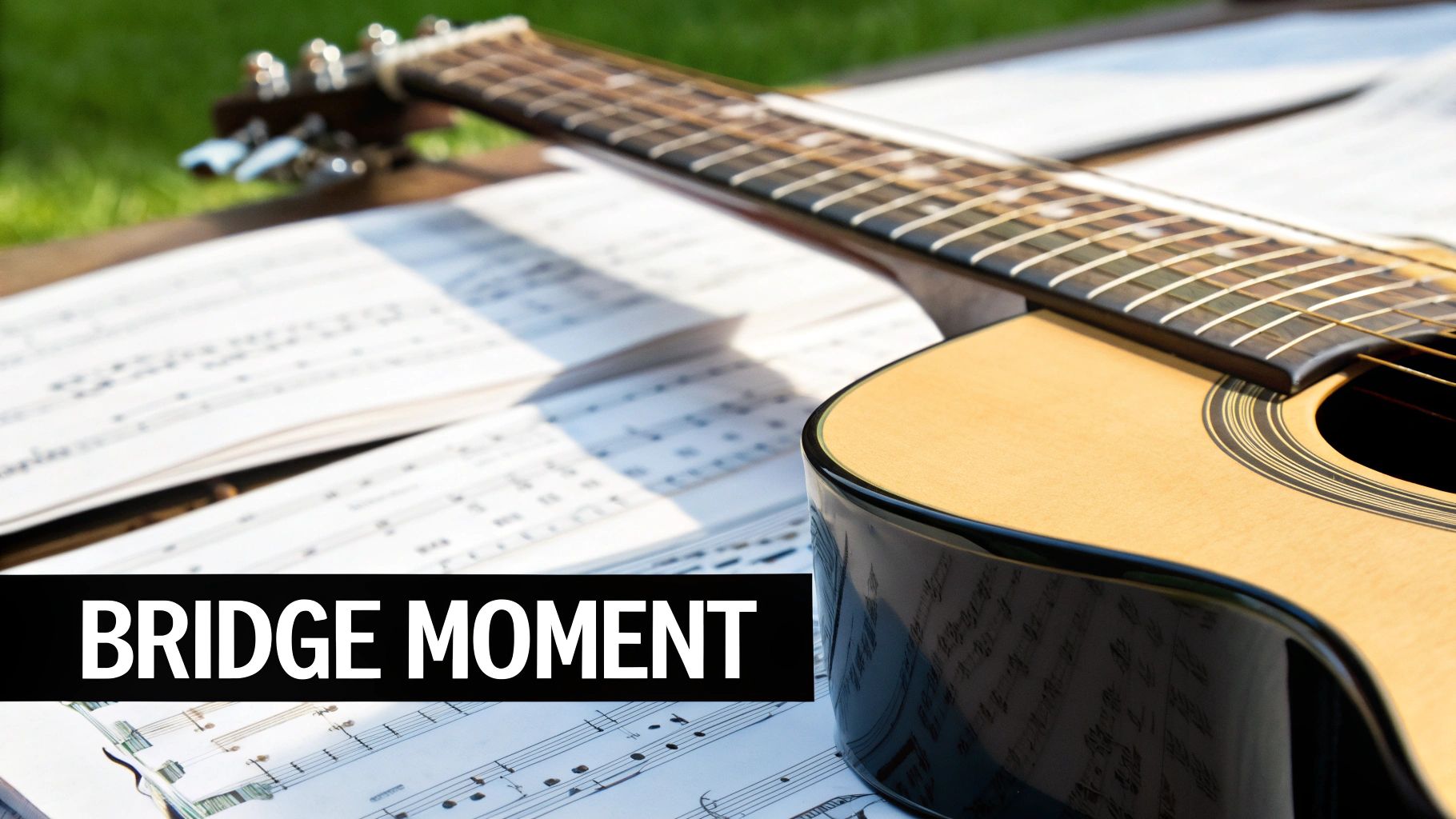
The song structures we’ve walked through are fantastic starting points, but they aren't unbreakable laws. Any seasoned songwriter will tell you the real goal is to serve the song. That often means tweaking—or even completely overhauling—a structure to fit the unspoken rules of your genre.
Think about it: the way you'd build a pop anthem is worlds apart from how you'd craft a raw folk ballad or a face-melting metal track.
Knowing these genre conventions is what makes a song feel right to its intended audience. It’s the difference between a track that connects and one that just feels a little… off. This is about learning the rules so you know how to bend them with purpose. It lets you take a blueprint like ABABCB and shape it into something that feels completely at home in its musical world.
Pop Music's Chorus-Centric Approach
In the pop universe, the chorus is king. Everything else in the song is basically there to support it. The entire track is engineered to rocket you toward a massive, unforgettable hook as quickly and effectively as possible. This is why you'll hear so many pop songs with short intros, tight verses, and punchy pre-choruses that build incredible tension right before the payoff.
- Top Priority: Catchiness and repetition are everything. The listener should be humming it after one listen.
- Common Tweak: Some songs even kick off with a piece of the chorus to hook you from the very first second. The verses are just there to set the scene before getting back to the main event.
- A Classic Example: Consider Katy Perry's "Roar." The structure is incredibly direct, laser-focused on getting back to that enormous, sing-along chorus.
Folk and Singer-Songwriter Storytelling
Where pop chases the hook, folk and singer-songwriter music is all about the story. Here, the verses carry the narrative weight and are truly the heart of the song.
For a storyteller, the structure’s job is to give the narrative a compelling flow. The music serves the words, not the other way around.
This focus on lyricism often leads to a strophic (AAAA) structure, where the same musical progression repeats for each verse as the story unfolds through new lyrics. You'll also see simple verse-chorus formats, but the verses are typically longer and more detailed. The emotional journey comes from the lyrics, not necessarily from big dynamic shifts in the music.
Rock and Metal Riff-Based Structures
Rock, metal, and their many subgenres are often built from the ground up on a killer guitar riff. That central riff becomes the song's DNA, and the sections are built around it. While you'll still find plenty of verse-chorus structures, the song's progression is really dictated by the different riffs.
- Intro Riff: Slams the door open and establishes the song's core identity.
- Verse Riff: Usually a more stripped-back or palm-muted version to let the vocals sit on top.
- Chorus Riff: The big one—often more powerful and open-sounding.
- Bridge/Solo: This is the perfect spot to introduce a totally new riff to provide contrast and keep things interesting.
It becomes less about a rigid A/B pattern and more about taking the listener on a journey through a series of interconnected, powerful riffs that create unstoppable forward momentum.
The Energetic Flow of EDM
Electronic Dance Music is a different beast entirely. It’s all about manipulating energy on the dance floor. The structure isn't really about telling a lyrical story; it’s about creating a physical experience. The key building blocks aren't verses and choruses, but rather builds, drops, and breakdowns.
A classic EDM track will methodically build tension with rising synths, frantic snare rolls, and filtering effects (the build). This all leads to a massive release of energy when the main beat and bassline crash in (the drop). After that peak, a breakdown strips everything away for a moment of melodic calm before the cycle starts all over again, ready to build and drop once more.
Structuring Your Song for the Streaming Age
Let's face it, how we find and listen to music has totally changed. We don't really sit down and commit to an entire album like we used to. Instead, it’s all about playlists, endless scrolling, and that ever-present skip button. This isn't just a listening habit—it fundamentally changes how you should be building your songs. Your arrangement is no longer just an artistic choice; it's a strategic one.
You have to get inside the head of a modern listener, the one with an itchy skip finger. The first 30 seconds of your song have become the most valuable real estate you own. If you haven't given them a hook to hang onto by then, they're probably already on to the next track. This reality has given rise to a songwriting trend called "front-loading." It’s all about getting to the good stuff—usually the chorus or a killer hook—right out of the gate.
The Thirty-Second Audition
Long, drawn-out intros? They’re a huge gamble if you’re trying to get noticed on a popular playlist. While a slow-burning, atmospheric intro can work wonders for an album deep cut, a song designed for discovery needs to make its point, and fast. This might mean tearing up your old song structure playbook.
Instead of a classic Intro-Verse-Chorus pattern, think about flipping the script:
- Start with the Chorus: Why wait? Hit them with your catchiest, most memorable section immediately. It’s a bold move, but it makes your song instantly stick.
- Tease with an "Intro Hook": Open with a little piece of the chorus. It could be a standalone vocal phrase or the main instrumental riff. This builds anticipation before you drop into the first verse.
- Just Shorten the Intro: You can still have an intro, just make it brief. Four bars is often plenty—enough to establish the mood without losing momentum.
This front-loading philosophy is a direct response to how streaming services work. With paid audio streaming being the number one way people listen to music—accounting for almost 24% of global consumption—you have to play the game. You can dig deeper into how streaming is influencing music trends to see just how critical that first half-minute has become.
Shorter Songs and Viral Moments
It’s not just intros that are shrinking; it’s the entire song. The three-and-a-half-minute radio standard is pretty much gone. Many of the biggest hits today are well under three minutes, and a surprising number are barely over two. This isn't just about shrinking attention spans. It’s about replay value and shareability.
Think about it: in the world of TikTok and Instagram Reels, a song's entire trajectory can change because of one perfect, 15-second clip. Your bridge or that killer pre-chorus might end up being more famous than the rest of the song.
This means every single section of your song needs to pull its weight. There's simply no room for filler anymore. As you map out your structure, ask yourself which parts could stand on their own. Does your pre-chorus have a unique rhythm that makes people want to move? Does the bridge deliver a lyrical gut-punch? Design these moments to be powerful and self-contained.
By building your song with these shareable "mini-hooks" in mind, you're not just writing a great track. You're creating something that’s engineered to catch fire on social media, which inevitably drives people back to the streaming platforms to hear the whole thing. It's a feedback loop, and it all starts with smart, modern songwriting.
Creating a Seamless and Cohesive Flow
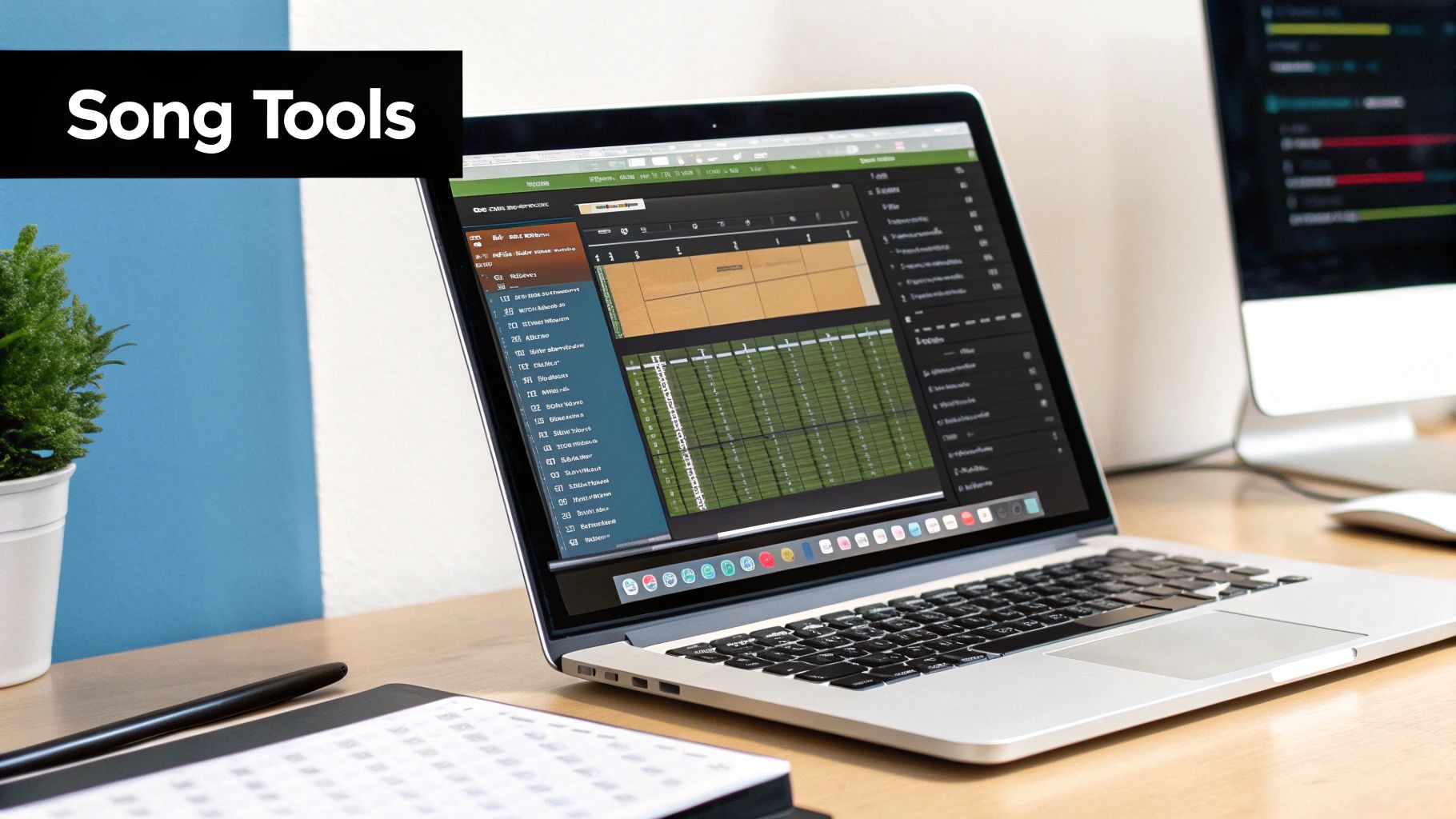
Knowing the individual parts of a song is one thing, but making them flow together is what truly separates a blocky demo from a polished, professional track. A great song structure isn't just about what comes next; it’s about how you get there. The real goal is to guide your listener from one section to another so smoothly that they barely even notice the seams.
Think of your transitions as the connective tissue holding your song's skeleton together. Without them, even the most killer verse or chorus can feel disjointed and jarring. It's all about creating forward momentum and anticipation, making each new section feel like a natural—and exciting—arrival.
Using Musical Glue for Smooth Transitions
To bridge the gap between sections, you need musical cues that signal a change is coming. I like to call these elements "musical glue" because they hold your structure together and build anticipation for what’s around the corner.
A few of my go-to tools for this are:
- Drum Fills: A classic for a reason. A quick drum fill at the end of a verse is a universal signal that the chorus is about to hit. It instantly breaks the established pattern and kicks up the energy.
- Synth Risers and Sweeps: Especially common in electronic and pop music, a rising synth sound or a whooshing noise effect creates an undeniable feeling of upward motion. It’s perfect for leading into a high-energy chorus or drop.
- Bass Walks: A short, melodic bass line that "walks" up or down the scale can smoothly connect the harmony of one section to another. It’s a much more sophisticated way to transition than just an abrupt chord change.
These production details have become more important than ever. With global recorded music revenues hitting approximately $29.6 billion in 2024—a 4.8% increase from the previous year—listeners have come to expect this level of polish. As you can find out in more detail by exploring how streaming shapes global music production on ifpi.org, a seamless structure is crucial for standing out.
Pro Tip: Don’t overdo it. Sometimes the most powerful transition is created by taking something away. Try dropping the drums out for the last bar of a pre-chorus. When they slam back in for the chorus, the impact feels massive.
Connecting Your Narrative Lyrically
Of course, transitions aren't just about the music. Your lyrics play a huge role in creating that cohesive flow. Each section's lyrics should logically follow the last, pushing your song's story or emotional argument forward. If your verse is asking a question, your chorus should feel like the answer.
Think of it like a conversation. A verse might set a scene ("Streetlights are painting the pavement wet"), and the pre-chorus might raise the stakes ("And I'm wondering if you feel it yet"). This builds a natural pull towards the chorus, where you finally reveal the core emotional theme.
Common Song Structure Questions Answered
As you start piecing your tracks together, you’re bound to hit a few common snags. Knowing the textbook definitions of song parts is one thing, but knowing when to bend or even break those "rules" is where the real artistry comes in.
Let’s dig into some of the most frequent questions I hear from songwriters. There's rarely a single right answer, but thinking through the options helps you make creative choices that truly serve your song.
Does Every Song Need a Bridge?
Not at all. A bridge can be an incredible tool for adding a fresh perspective or dynamic shift, but plenty of amazing hits get by just fine on a simple verse-chorus loop.
Think of a bridge as a problem-solver. Does your song feel a little stale or repetitive after the second chorus? Does it need a new emotional angle or a moment of quiet before a huge final chorus? That's the perfect time to write a bridge. But if your song already has great momentum and feels complete, forcing one in can actually kill the vibe. Let the song tell you what it needs.
How Long Should My Intro Be?
This really comes down to two things: your genre and where you imagine people listening to your song. In the world of streaming, many pop and electronic tracks have incredibly short intros—sometimes just 5 to 10 seconds long. The goal is to hook the listener before they even think about hitting the skip button.
On the flip side, if you're crafting an immersive album experience, a cinematic piece, or a sprawling rock anthem, a longer, mood-setting intro can be far more powerful. It gives you space to build a world for the listener to step into.
The real job of an intro isn't to be a certain length; it's to make a promise to the listener about the journey they're about to take. Make it a promise you can keep.
Can I Start a Song with the Chorus?
Absolutely! This is a super popular and effective trick, especially in modern pop, EDM, and hip-hop. Dropping the listener straight into the main hook makes your song instantly memorable.
You grab their attention from the first beat. From there, you can pull back into a verse to start telling your story. When the chorus comes back around, it already feels familiar and satisfying. There's a reason this is such a go-to move for chart-toppers. And if you're looking for more ways to make your songs stand out, you'll find plenty of practical songwriting tips for beginners to guide you.
At ChordX, we're dedicated to helping you turn your musical ideas into polished, professional tracks. Explore our resources and take the next step in your creative journey. Learn more at https://chordx.io.


